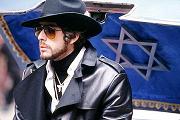Against a backdrop of slams at the U.S. government and lectures on how the architectural industrialization and tourist culture is ruining the local flavor of N.Y.C. neighborhoods, “Looking for Kitty” (opening today) is a story of friendship between two men, both of them chasing memories of the women who have left them.
Edward Burns’ grieving widower is a private detective who is hired by a high-school baseball coach (Paul Krumholtz) to help him find his missing wife. Krumholtz plays a good, if insular guy from Peekskill (which Burns’s character constantly calls “Poughkeepsie”) whose entire life was centered on the local level–his job as a Little League coach and his wife, nothing else. Each character in his own way has excluded himself from experiences outside the parameters of his comfort zone; by being in each other’s lives they teach each other to embrace the reality of their circumstances and engage with the world around them. The two protagonists are themselves “New York holdouts,” old-school guys who refuse to relinquish their hold on their emotional geography and persist in standing strong against the winds of change.
Krumholtz’s dogged adherence to the belief that his wife was seduced by a culture of excess and that she really wants to come back is pathetic–but it is also relatable. To varying degrees, we’ve all been there, adhering to ideals that we’ll never reach or wanting people who are out of our reach. For his part, the detective explains that he’s not using the internet because he likes to do things the old-fashioned way, “the way Bogie woulda done it.” Yet, he has rejected one of the more old-fashioned elements with which he was raised, Catholicism (a common theme in Burns’s work), because he notes that even without the religious guilt, “I felt sh—y enough about myself already.” The two help each other change, and even though each one goes home alone, they ultimately “leave because it is time to go,” which is a subtle lesson that not everyone learns.
Portraying a neighbor, Connie Britton provides Burns’ character with a moment of distraction and a tortured smolder, while Rachel Dratch, playing a woman in a bar, serves as a temptation to the fiercely loyal Krumholtz. This film is also noteworthy for the return of Ari Meyers (of TV’s “Kate and Allie”), and features some odd but evocative and moving moments from both Burns and Krumholtz.
All of the women are underused, which is probably intentional, since the press kit talks of the “mechanics and mysteries of male bonding.” Though it’s pretty clear that the connections between Burns’ and Krumholtz’s characters are superficially about beer and baseball, there is something deeper that binds them: the brotherhood of loss and a lingering obstinacy when it comes to accepting what life has dealt.
I left the theater feeling sadder, but not significantly. The experience felt a little like tofu–spongy, with an indeterminate texture; I knew there was protein to the dish as a whole. But when lasting satisfaction eluded me, it was hard to admit that it was over. Which is, perhaps, the point.


